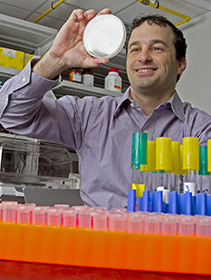Patrick Cirino, associate professor of chemical and biomolecular engineering at UH Cullen College of Engineering, earned a three-year, $300,000 National Science Foundation grant to continue developing and implementing genetic tools that advance synthetic biology and metabolic engineering. Cirino’s research group focuses on biocatalysis, which involves the engineering of proteins, metabolic pathways and entire microorganisms to produce various biochemicals.
A powerful approach to engineering these complex biological systems is directed evolution. After introduction of genetic diversity and creation of a gene library, a search strategy is employed to identify rare variants showing improvement in the property of interest, such as production of a biochemical.
The development of an accurate, sensitive and high-throughput search is a significant challenge associated with directed evolution. In the simplest cases, the growth of cells expressing the gene library is correlated with evolution of the desired property, so the fastest growers are easily identified using any number of growth-dependent assays. Alternately, high-throughput spectroscopy methods are used to find the winning cells when the desired biochemical or its derivative has unique and easily detected spectral properties. However, such simple screens are not options in many instances.
Research supported by this grant focuses on development and application of new approaches for screening large libraries of mutant microorganisms to identify rare mutants not correlated with cell growth and not distinguished by unique chemical or spectral properties that are capable of new or enhanced biosynthesis of desired products. In lab research and industrial bioprocessing, various E. coli strains are popular for their genetic amenability, metabolic versatility, fast growth and successful track record for engineering applications.
Genetically modified E. coli strains already exist for a variety of applications, including overproduction of biofuels and high-value protein therapeutics. Still, yields and productivities are often far from optimal, owing to complexly coordinated and poorly understood metabolic constraints. Metabolic engineers use as much information as is available from studies in systems biology, protein biochemistry and microbial physiology to make predictions about best designs for new microorganisms, and these rational design attempts are often greatly enhanced when combined with combinatorial genetic approaches. Such experiments are much like searching for a needle in a haystack.
“Even for a typical, single enzyme, far more possible sequence variations exist than there are atoms in a human body, or even stars in the universe,” Cirino said. “So it’s a great challenge to narrow our search and to find new and poorly understood genetic modifications that are both compatible with the host’s natural metabolism and allow for novel or improved production of a desired chemical.”
The Cirino group has addressed this challenge by developing in vivo molecular reporters. Their approach is to modify a protein called AraC, which naturally regulates gene expression in E. coli. The modified AraC activates desired genes, which translates to production of desired proteins, in response to specific chemicals produced in the cell. These designed biosensors can then correlate the improved production of a compound by rare library members with the production of an easily measurable protein, such as green fluorescent protein.
“We can easily screen 100 million different cells in one day, if its fluorescence we are looking for,” Cirino said. "In many cases, we want to force cells to produce chemicals by directly competing with their natural objective of growing and using carbon and energy sources efficiently.”
Overcoming many, coordinated metabolic constraints that limit such biochemical production requires a large number of synergistic genetic modifications, without excessive compromise to cell viability. To accomplish this, Cirino’s proposed research aims to combine recent technological advancements for rapid creation of high-fidelity genome libraries with his group’s unique customized molecular reporting capabilities. They plan focus on large, expression-level libraries containing combinations of many genes that are key to E. coli central metabolism in their search for enhanced production of chemicals like mevalonate and triacetic acid lactone, whose biosyntheses utilize precursor metabolites that compete directly with central metabolic pathways.
Unique combinations of genome modifications identified through this work will allow engineered E. coli to more efficiently convert abundant and renewable sugars derived from biomass into precursor metabolites and a variety of chemical products, such as biofuels and building blocks for producing natural products. The same recombineered genome libraries will also be available to the metabolic engineering community for future studies.
In addition to advancing understanding in sustainable biochemicals production, Cirino’s research will yield new insights into metabolism and microbial physiology, thereby contributing broadly to many biology-related disciplines. His work will also support educational activities for four UH graduate students as well as underrepresented undergraduate and high school students.
